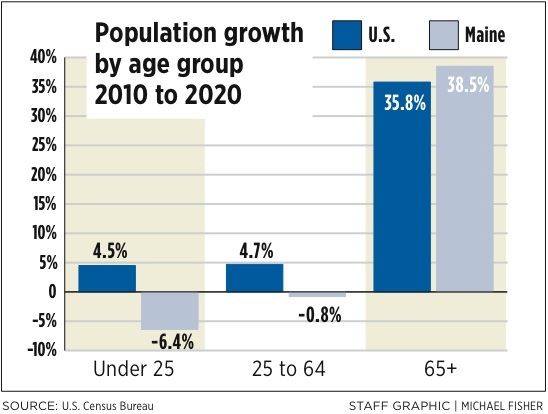I’m doin’ all right, gettin’ good grades.
My future’s so bright, I gotta wear shades.
– Timbuk-3
In its most recent long-term employment projections (2008 to 2018), the U.S. Department of Labor estimated that total employment in Maine would grow by about 14,400 jobs by 2018, an increase of 2.1 percent. For the U.S. as a whole, the Labor Department projected an increase in total employment of 10.1 percent.
In its most recent population forecast, the Bureau of the Census projected that total population in Maine between 2010 and 2020 would grow by about 51,500 people, an increase of 3.8 percent. For the U.S. as a whole, the bureau projected a total population increase of 8.7 percent.
So why the big differential between population growth and employment growth? Why, when population growth in the U.S. as a whole is “only” twice as fast as in Maine, is employment growth five times as fast?
Part of the reason, undoubtedly, is regulatory red tape and high taxes. Maine does not have a friendly business environment, and efforts to improve it are valuable.
But high taxes, regulatory myopia and bureaucratic duplication are insignificant compared to the major reason for Maine’s way-below-average employment growth.
That reason is people. We just don’t have enough people to fill jobs and to give potential employers the confidence that they can expand their businesses here.
Consider the chart that accompanies this column. We all know about aging baby boomers – most of us are part of the crowd. Over the next decade, the age 65-plus population in the U.S. will grow by nearly 55 million, an increase of 36 percent. In Maine, that group will grow by nearly 82,000, an increase of 39 percent. Boomers there, boomers here.
But what of the younger age cohorts?
In the U.S. as a whole, the population age 25 to 65 – the prime working-age population – will grow by just over 170 million, an increase of nearly 5 percent. In Maine, that age group is projected to drop by nearly 6,000 over the next decade, a decline of about 1 percent.
Who’s going to locate a growing business in a state with a below-average level of higher education attainment and a working-age population that’s expected to decline over the coming decade?
And for the under-25 age cohort, the news is even more dire. In the U.S. this young group is expected to grow by nearly 110 million by 2020, an increase of nearly 5 percent — not growth of baby boom proportions, but growth nevertheless.
In Maine, however, this youngest age cohort is projected to decline by more than 24,000, a drop of more than 6 percent.
Whatever pennies we may save cutting budgets this year will be swept away in future years by the dollars spent to staff, administer and heat schools with fewer and fewer students in them.
So the demographic point is obvious. Maine can’t afford to look inward to solve all our problems.
No matter how hard we try to balance our budgets by making regulations easier for ourselves and keeping out undesirables, such efforts are doomed to failure. Those with good grades and bright futures will just continue to leave.
The only escape from our demographic destiny is to look outward, to welcome others here, to strengthen our links to the rest of the world, to grab a larger share of that 10 percent national job growth.
Our future can be bright, but only when we get some more of those young kids wearing shades.
Charles Lawton is senior economist for Planning Decisions, a public policy research firm. He can be reached at: clawton@maine.rr.com
Copy the Story Link
Send questions/comments to the editors.



Success. Please wait for the page to reload. If the page does not reload within 5 seconds, please refresh the page.
Enter your email and password to access comments.
Hi, to comment on stories you must . This profile is in addition to your subscription and website login.
Already have a commenting profile? .
Invalid username/password.
Please check your email to confirm and complete your registration.
Only subscribers are eligible to post comments. Please subscribe or login first for digital access. Here’s why.
Use the form below to reset your password. When you've submitted your account email, we will send an email with a reset code.